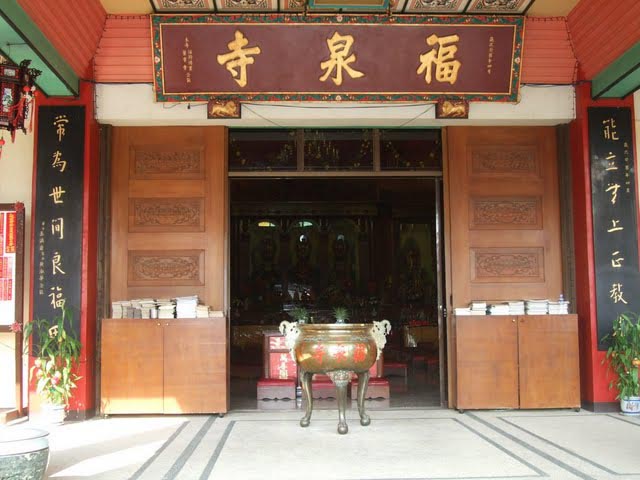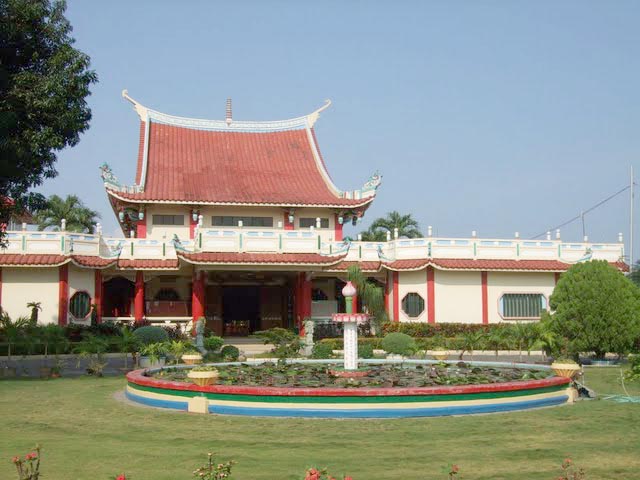Editors Note: This is the 33rd of a series about the 36 Chinese Buddhist temples of the Philippines. Much of the information is from a thesis of Venerable Chuanmiao (Hsuan Chuang University, 2008), a Buddhist monk affiliated with the Thousand Buddha Temple in Quezon City.
33. Hoc Chuan Temple 福泉寺
J.R. Estrada Street, Tetuan, Zamboanga City
Tel. (062) 991-0411
In 1881, a man named Chen Jun (陳梭) brought a statue of Guanyin from the Longshan Temple (龍山寺) in Anhai, Quanzhou and set up a private shrine in the Tetuan district of Zamboanga city.
A more suitable place was rented in 1900 and the Hoc Chuan Temple was built. The first character, Fu in Mandarin, recalls Fujian, and the second character, Quan in Mandarin, recalls Quanzhou, where the statue of Guanyin came from. The name also evokes the idea of the temple as a wellspring of happiness and wisdom (福慧之泉源).
In 1937, Yang Shichang (楊世昌) wanted a permanent home for the temple, and formed an association to work towards this purpose.
He headed the association and raised the funds to buy the property in Tetuan where the first shrine was located. Plans were interrupted by World War II, and construction began only in 1947. Building work was completed in 1950.
Although the temple was famously visited by Yinshun (印順) in 1955, it could only be a proper temple with the presence of monastics. The board of directors wanted this to become a reality.
In 1958, they succeeded in inviting Ven. Chuanguan (傳貫) and two companions, Chuanhai (傳海) and Daolü (道律), to come and run the temple. Chuanguan was the abbot. He was born to a Buddhist family in Hui’an, Fujian. Ordained and trained at temples in Jinjiang, Quanzhou, and Qingdao, his training included a period under the renowned monk Hongyi (弘一). His spiritual practice also involved a three-year solitary retreat.
The invitation from Zamboanga came in 1956, but the processing of travel papers necessitated a two-year stay in Hong Kong until, with the help of Ruimiao (瑞妙) of Che Wan Temple in Manila, the three monks were able to travel to Zamboanga in 1958.
Chuanguan founded the Avalokitesvara School (觀音中學) beside the temple in 1968, and in 1991 spearheaded the total renovation of the temple; its buildings were in urgent need of repair. Chuanguan died in 1993 at 89.
The board of directors once again searched for a new abbot. They found Chuanchan (傳禪), also from Fujian, who had arrived in Manila in 1993 upon the invitation of Guangchun (廣純) to assist at the Thousand Buddha Temple in Quezon City.
Chuanchan arrived in Zamboanga in 1995 and on the Guanyin feast on the ninth lunar month, Weici (唯慈) presided over his installation as abbot, the launching of the temple’s charity clinic, and the school’s 28th anniversary.
During his time as abbot, Chuanchan made numerous improvements to the school and upgraded some of the temple facilities.

Main buildings. The temple entrance leads to a sizeable plaza with a pond in the center.
The temple building has a large, air-conditioned central hall where the altar enshrines Guanyin as well as the three Buddhas. Behind it is the ancestral hall, and a special pavilion honoring Chuanguan. The office, refectory, and monastics’ living quarters are in side buildings, thus somewhat forming the Chinese character tong (同).
Leadership and primary activities. Chuanchan is still the abbot, assisted by another monk and two nuns. Six teachers from China who teach at the school also reside in the temple.
The temple has two major services each year: the lunar new year to pray for blessings, and the three-day chanting on the seventh month. Regular devotion days are observed on the first and 15th of the month.
On Friday mornings, groups of students from the school are brought to the temple for short prayers. In the past, there was a regular Sunday service but this has been discontinued due to declining numbers of attendees.
The women’s association has about 80 members and helps the temple organize activities, including a charity clinic held twice a month. To celebrate the lunar new year, there is always a major program where the school and temple communities come together. — — First published in Tulay Fortnightly, Chinese-Filipino Digest 26, no. 4 (July 23-Aug. 5, 2013): 12-13.





